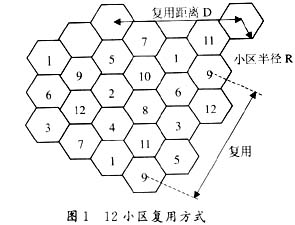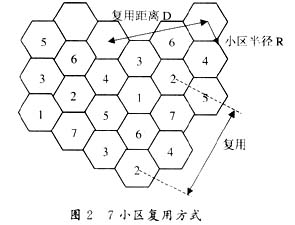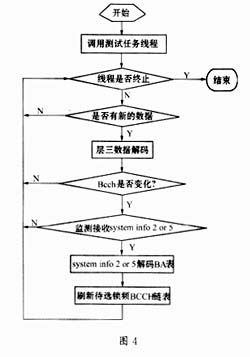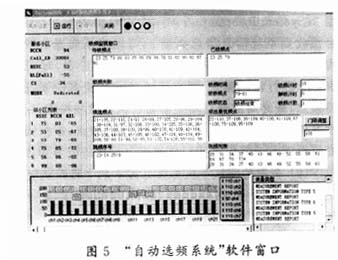Keywords: frequency planning, frequency reuse, automatic frequency locking, BCCH allocation table
1 Introduction Although the adoption of advanced digital technology can make the GSM system have a greater increase in capacity than the TACS system, it still cannot meet the needs of user growth. Especially when it is necessary to provide high traffic demand at a certain time and in a certain area, in order to improve the user connection rate and provide more channel resources, network operators usually take emergency to increase the carrier frequency to meet the call needs of high density crowd areas . However, the frequency planning is directly related to the QoS of the communication system. In this regard, this paper presents the software implementation method of automatic frequency selection, which not only meets the need for system expansion in mobile emergency communications, but also ensures the QoS of the communication system.
2 Principles of frequency planning When frequency planning, we mainly want to consider how to achieve high system capacity as much as possible. In other words, it is how to achieve high traffic density (as many users as possible per square kilometer) under the premise of guaranteeing voice quality at a certain service level. Due to the limitation of frequency resources, the frequency of a given cellular system is limited (the 900MHz frequency bands allocated to the GSM cellular mobile communication system of China Mobile and China Unicom are each 6MHz-30 frequency points). One problem to be solved by frequency planning is how to use frequency resources more efficiently. Compared with the traditional mobile system, the cellular system improves the frequency band utilization rate through a more efficient frequency reuse mode.
In the traditional mobile communication system, the base station antenna should be set as high as possible, the power output should be as large as possible, and the coverage area of ​​a base station should also be as large as possible. At the same time, in order to ensure that the level of the interfering signal is lower than the receiving threshold of the receiver, the distance between systems using the same frequency should be far enough. In fact, the traditional mobile system is a noise-limited system, and its final base station coverage is determined by the receiver's receiving threshold. However, in practical applications, even if the interference signal is large, as long as the useful signal level is higher than the interference signal level by a certain dB value, the user can still receive it. The cellular mobile communication system uses this feature to achieve the required C / I (co-channel interference) and C / A (adjacent frequency interference) values ​​by frequency reuse at a certain distance. For a mature cellular mobile communication system, its final base station coverage is determined by video interference and belongs to an interference-limited system. The interference protection ratio of a general cellular system is:
Co-channel interference (C / I): Analog> 18dB, GSM> 9dB
Adjacent frequency interference (C / A): Analog> -23dB, GSM> -9dB
The cellular system divides the coverage area into several small base station coverage areas, and then divides the available frequencies into several groups. Each cell uses a group of frequencies and reuses the same frequency at a certain distance. Although after frequency grouping, the number of users served by the frequency band will be reduced, but because of the frequency reuse method, it is equivalent to that the system has "multiplex times times the frequency band times the coefficient L (L varies with The frequency and frequency band change, L <= 1) â€. Taking a city as an example, the available frequency of the GSM system is 12MHz, a total of 60 frequency points, can provide 466.3Erl (GOS = 2%, 480TCH), 4 × 3 multiplexing is divided into 12 groups, each group of 5 frequency points, complex Used 4 times, it can provide 31 (GOS = 2%, 40TCH) × 12 × 4 = 1488Erl, when GOS = 2%, it is equivalent to have 1489 TCH (186 frequency points), 37.2MHz bandwidth. This is the basic principle of effective frequency utilization in cellular systems.


Figure 1 is the ideal 12-cell multiplexing method, which divides the frequency into 12 groups for multiplexing. Assuming that the parameters of each base station are the same, the terrain features are also the same, mainly using the multiplexing distance to control the interference signal. Let the cell radius be R and the reuse distance D. For the GSM system, the minimum value of C / I is 9dB, that is, C / I = 7.94. Considering the situation of 6 co-channel interferences, there are:

![]()
It is easy to see that when the cell range is constant, the larger the N, the greater the co-channel multiplexing distance, and the easier it is to control co-channel interference. But at the same time, the larger the N, the fewer the frequency of each group, and the fewer users can be accommodated, so the key is how to determine the appropriate value of N. In addition to multiplexing distance affecting co-frequency interference, the use of power control, sectorization (using directional antennas), discontinuous transmission and frequency hopping can all reduce interference. In fact, with the clever use of terrain and features, while reducing the multiplexing distance, we can also make the co-channel interference meet the corresponding system requirements. In any case, the fundamental measurement standard for the multiplexing method finally determined is to make the co-channel and adjacent-channel interference meet the system requirements 90% of the time and 90% of the time. For the analog system, the common multiplexing method of directional base stations is 7 × 3 (divided into 7 groups, each group is divided into 3 groups, allocated to 3 sectors, the same below), 4 × 6, etc., GSM system usually uses 4 × 3, 2 × 6 (using non-frequency hopping system frequency planning, frequency hopping system bcch frequency planning), 3 × 3 (using baseband frequency hopping non__bcch frequency planning), 1 × 3 (using synthesizer hopping Frequency non__bcch carrier frequency plan).
3 Automatic frequency selection software implementation method In order to meet the needs of temporary capacity expansion, most operators adopt the method of frequency expansion to increase the system capacity. They had to consider the following questions: how to choose a suitable optimal frequency point without changing the original frequency planning parameters; after introducing the new frequency point, the interference effect on the original system was reduced as much as possible. The traditional method is a manual trial frequency selection method, and its disadvantages are:
(1) The operation is more cumbersome, and the selected frequency point often brings more system interference with the adjacent frequency, and the optimal effect cannot be achieved;
(2) Frequency selection is often unsuccessful. It needs to be repeatedly screened many times. The frequency selection time is long and cannot meet the emergency requirements;
(3) Experienced engineers are required to estimate the implementation, which is inappropriate in terms of personnel cost.
According to the principles of frequency planning, GSM mobile communication theory, and the special functions of testing mobile phones, we can completely implement automatic frequency selection in emergency communications through software methods.
(1) When the GSM system is upstream, the mobile station can sample all neighboring cells several times within a SACCH multiframe period.
After averaging several samples, the mobile station reports the 6 neighboring cells with the highest average signal strength to the base station subsystem every 480ms; when the GSM system is down, the BCCH allocation (BA) table passes the System InformaTIon Message Type 2 )send. The mobile station receives the system information message type 2, and can confirm the frequency points generally used in the surroundings. The mobile station performs frequency lock measurement on each BCCH according to the broadcasted BA information table, and can continuously find more system use frequency points. The surrounding frequency points are all locked by the mobile station, and the frequency selection candidate frequency points that can be locked around the unused frequency points are selected, and the optimal emergency frequency point is selected according to the frequency planning principle and the co-adjacent frequency interference threshold.
(2) General test mobile phones have the following two special functions:
· Test phone can be locked on a BCCH in idle mode;
The test mobile phone has the function of frequency sweep. In the GSM system, the test mobile phone can scan the entire GSM working frequency band to calculate the signal strength of each frequency point. If the frequency point is interfered with sufficiently small, the mobile phone can demodulate BSIC and CELLID.
From (1) and (2), the system controls the test mobile phone with the help of AT commands, and design software modules to realize functions such as automatic frequency locking, automatic calculation, and automatic analysis. Automatic frequency selection uses the following frequency-locked propagation algorithm:
According to the principle of frequency planning, the neighboring cells defined by the BCCH frequency of each serving cell have intersections and are not empty. By constantly frequency-locking the BCCH, new neighboring cell BCCH can be continuously discovered. Define the union a of the neighbor cell list defined for each primary cell by defining the number of all BCCH frequency points that need to be locked. Perform continuous frequency-locking test on all elements in the set and record the intensity value of each BCCH signal after frequency-locking. Define the frequency sweep data set b (GSM900 frequency band range is 1.124), and at the same time, use the frequency sweep function of the test mobile phone to calculate the BCCH signal strength value of the frequency sweep. Therefore, the formula for calculating the candidate frequency point is: c = b-a. When calculating the best candidate frequency point, the signal strength of each element in c in the scan data should be less than -100dbm.
The system sets the following parameters:
· Frequency lock timeout threshold, frequency lock frequency test time, frequency unlock time;
· Number of cycle tests.
4 Analysis of main software modules The main software modules are analyzed as follows:
(1) Create a union list list__waitfortest to store the target frequency to be tested;
(2) Create a record list of tested frequency points list__tested, which is used to add the frequency points to the list after the system locks frequency;
(3) Extract the BCCH from the list__waitfortest list according to the queue, and force the mobile phone to lock the frequency to occupy the BCCH;
(4) If the test mobile phone occupies the BCCH successfully, add the BCCH to the list tested list footer and delete the BCCH node in the list waitfortest list. If the frequency point occupation times out, the system releases the task,
Push the occupancy failure frequency point into the failure stack and at the same time in the list. Delete the BCCH node in the waitfortest table;
(5) Regularly test the BCCH occupancy time. When the time is up, unlock the frequency of the mobile phone, the mobile phone will return to the free IDLE mode, re-select a new cell, compare the two linked lists, and calculate the next BCCH frequency to be tested;
(6) The two linked lists are relatively equal. After one round of testing is completed, the signal strength distribution of the test frequency point is counted, and the best candidate frequency point is calculated in combination with the frequency sweep data;
(7) After calculation, the best candidate frequency point should be satisfied in the list__waitfortest table, the intensity statistics of the time-sweep data number is less than --100dbm, so the selected frequency point can basically ensure the cleanliness of the frequency point and the degree of interference to the system And the degree of interference can be reduced to a minimum.
5 Module functional analysis process
5.1 Automatic Frequency Locking Process The automatic frequency locking process is shown in Figure 3.

6 Conclusion This module has been integrated into the Eastcom2000 wireless network test and optimization software system ("Automatic Frequency Selection System" software window is shown in Figure 5), which has been widely used in domestic wireless network operations, effectively solving The question of choosing the best frequency.


references
2 Yan Yongqing. Measures to eliminate co-channel interference in a simulated cellular mobile communication system. Jiangsu Communication Technology, 1997 (4)
3 Pang Qinhua and other translations. Cellular mobile communications-analog and digital systems. Beijing: People's Posts and Telecommunications Press, 1997
4 Huang Jian, etc. Mobile communications. Xi'an: Xidian University Press, 19925 Qi Yusheng, etc. Modern mobile communication system. Beijing: People's Posts and Telecommunications Press, 1999
Function: The LED Aluminum Flashlight has 3-5 modes;
Feature: The LED Aluminum Flashlight usually high power and super bright;
Trait: The products are waterproof, shockproof and tactical;
Method of application: Simple on/off push button operation;
Range of application: The LED Aluminum Flashlight for emergency events, camping, outdoor activities and indoor;
Adervantages: Our products are saled with factory price, and the quality can guarantee, lastly we provide warranty for 1 year.
LED Aluminum Flashlight
Aluminum Led Flashlight,Aluminum Torch,Electric Focus Led Flashlight,Aluminum Portable Lights
Ningbo Henglang Import & Export Co.,Ltd , https://www.odistarflashlight.com